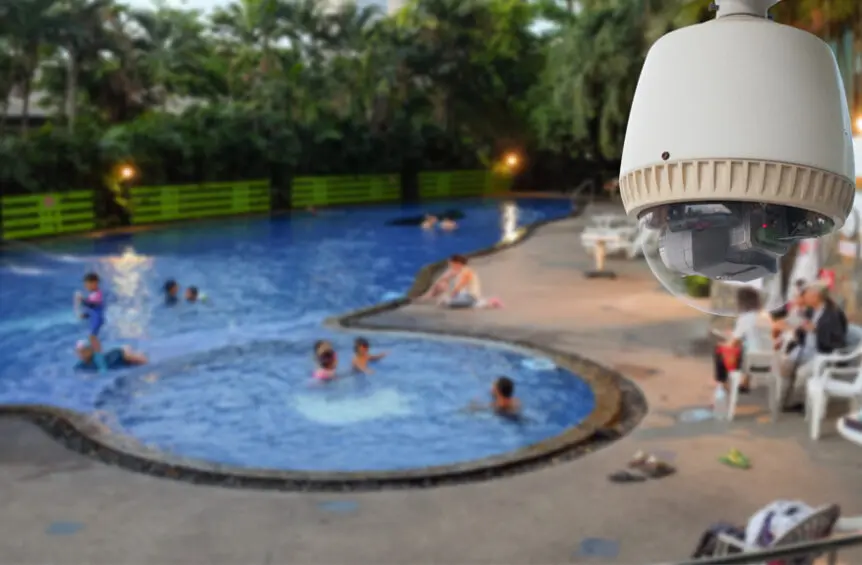Summer has arrived and businesses across the country are starting to face numerous security challenges that can be detrimental to their operations. With more events and activities occurring during the summer months, there is an uptick in break-in attempts and physical security breaches that force properties to implement strong protocols.
At FlyLock Security Solutions, we’re here to help bolster your access control and surveillance, ensuring you create more accountability in the workplace. We’ll help you keep a close eye on seasonal employees, while implementing security measures that protect your equipment and businesses. Let’s take a look at the leading summer security threats you may encounter and how to attack them.
TABLE OF CONTENTS
Commercial Security Topics This Blog Includes:
Threat #1: Physical Security Breaches During Vacation Season
Why it's a threat:
Vacation season leaves homes and businesses more vulnerable. Small businesses often operate with a reduced staff in the summer, leaving them as a primary target for intruders. This opens up opportunities for criminal activity outside of business hours, without the proper defense.
Residential properties are also easy targets for break-ins, as without reliable business security systems, unattended homes face increased physical security challenges with limited supervision. That raises the question, how do you put together a strategic plan to protect your property from potential intrusions?
Break-in Prevention Strategies:
Install Advanced Surveillance Systems: Commercial security solutions like CCTV and surveillance systems alert authorities in the event of a break-in, while offering features like motion detection and 24/7 live monitoring. Through these systems, your business is well suited to prevent break-ins.
Invest in Remote Access Management Tools: Through our remote access management features, businesses can control or monitor access from anywhere, even when they’re away from their property on vacation. From regulating access for visitors and staff, or using live footage generated by security camera systems, our team helps identify potential security risks in real-time.
Schedule Regular Inspections: It’s important to schedule routine business security maintenance services as without it your property can become more vulnerable. With these inspections, you can uncover potential weaknesses in your infrastructure, allowing you to address issues ahead of time and prevent further damage.
Threat #2: Tailgating & Unauthorized Entry
Why it's a threat:
With the increase in foot traffic during deliveries and summer events, it becomes easier for unauthorized individuals to enter your property. Distractions can prevent staff from spotting break-in attempts, heightening your business’s exposure to security risks.
“Tailgating” occurs when intruders follow employees into secured areas during busy hours to obtain credentials or passcodes. Without the proper access control protocols in place, workplace safety can be compromised, leading to unauthorized access.
How to Avoid Tailgating:
- Choose Live Monitoring Strategies: Installing video surveillance systems gives you more protection at your main entry points, as it can deter criminal activity, while giving you real-time insights into identities and movement patterns.
- Conduct Effective Employee Training: In educating your employees on tailgating, your staff will be more prepared to handle these situations and identify warning signs. This will create a safer workplace, where employees can spot suspicious activity before it escalates.
- Install Advanced Access Control Systems: By implementing physical security solutions like biometric or multifactor keyless entry systems, you can make it more challenging for intruders to gain access using strict digital credentials that can’t be duplicated. Traditional threats like lock bumping are no longer possible with these commercial door security systems in place.
Looking to learn how FlyLock is growing their security service offerings?

Threat #3: Cybersecurity Vulnerabilities from Seasonal Workers
Why it's a threat:
Employing temporary or seasonal workers can help during busy summer months but can create cybersecurity threats. Temporary staff may use unsecured devices that affect the integrity of your network, creating opportunities for sensitive data to be compromised.
Your business security infrastructure could become vulnerable as security breaches lead to various issues including access credentials being obtained, disrupted security camera video feeds, or corrupted data like activity logs. These incidents could affect operations significantly.
How to Improve Cyber Security:
- Create Strong Passcodes: Create complex, strong passwords for your systems and change them regularly so they can’t be replicated. If you have a keyless entry system, you can change credentials in real-time if a code is forgotten or compromised.
- Enforce Strong Access Protocols: To maintain effective access control, establish clear restrictions for visitors and staff, establishing role-based permissions that prevent temporary hires from accessing data full-time employees can.
- Run Regular Cyber Training: Ensure your staff is regularly trained so they can be aware of the leading cybersecurity threats. Through these sessions, they’ll be well versed in commercial security strategies that will help protect sensitive company information.
Threat #4: Outdoor Equipment Theft/Tampering
Why it's a threat:
Ensuring your security equipment is secure at all times is essential, as your business or residential property can become more vulnerable, especially during vacation time. Damaged surveillance systems can create blind spots, leaving your property exposed to physical security threats. When your commercial security systems and door hardware are tampered with, it weakens your overall defense, leaving your property in a vulnerable position.
How to Prevent Physical Security Equipment Tampering:
- Install Durable Equipment: Choose long-lasting, weatherproof security cameras and access control systems that are resistant to damage. For full coverage, it’s important to place them strategically so your property is well protected.
- Set Up Alerts/Live Reporting: Setting up alerts for break-in attempts can help you quickly spot active threats, while giving you insights into access patterns. This enables you to keep a closer eye on your equipment, deterring intruders with alarms that prevent them from causing further damage.
Threat #5: Seasonal Employee Turnover & Insider Risks
Why it's a threat:
Short-term hires who bypass strict background checks can create potential business security breaches and uncertainty, especially when they’re left untrained. These employees are often times overlooked, leaving businesses exposed to insider theft. A lack of security training for staff also creates some vulnerability, as without the proper training, employees aren’t educated on what to look for and how to prevent the occurrence of insider theft.
How to Implement Effective Access Control for Summer Events:
- Conduct Effective Security Onboarding: By undergoing thorough onboarding, businesses can emphasize strict security protocols so both permanent and temporary staff understand organizational safety measures. This creates more accountability in the workplace, having procedures in place to combat insider theft.
- Implement Role-Based Access Control: It’s important to implement credentials based on organizational roles, as this strategy ensures specific access is restricted to only authorized personnel. Permissions can be adjusted so only select areas are accessible, leaving no room for unauthorized entry.
- Set Up Activity Logs: Having a process in place to monitor access logs and patterns enables businesses to identify unusual behavior, supported by live alerts that combat insider threats. With seasonal employee turnover, it’s critical that every employee can be easily monitored.
FlyLock Will Keep Your Business Safe this Summer
Frequently Asked Questions
What are the 3 main ways to prevent security threats?
The three primary solutions to prevent security threats are access control, multi-factor authentication, and conducting security audits. By installing access control systems, you can effectively restrict entry to sensitive areas through strict access methods like key fobs or biometrics. Multi-factor authentication creates an extra layer of protection outside of a simple passcode, requiring additional verification through a mobile device. Security audits are essential, as by reviewing security protocols consistently, you’ll be able to identify vulnerabilities ahead of time, allowing you to stay ahead of emerging physical security threats.
What is the most common insider threat?
The most common insider threat is the misuse of access within an organization. Existing or departing employees may use their privileges to their advantage, obtaining access to specific resources or data, leaving the business at risk. It’s important to regularly follow access patterns and activity logs to identify any suspicious activity occurring on your property.
What is the most common security threat?
The most common security threat is malware, which can significantly damage a network. This can be detrimental for businesses, as viruses and ransomware can create data breaches that leave them vulnerable to additional threats. It’s important to follow strict cybersecurity measures as malware can damage security systems and allow criminals to obtain sensitive data.


